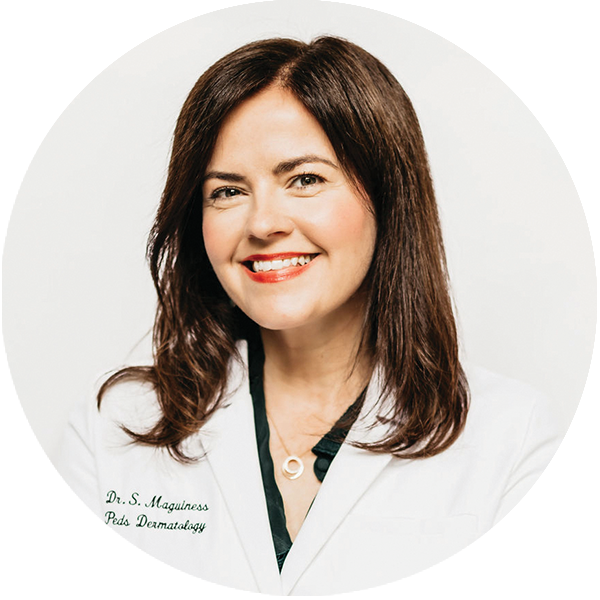The pediatric dermatologist who rescued a little girl from a rare and dangerous birthmark
You’d never know Piper Cramer was born with a birthmark that covered more than half of her face.
Never know how scared her mother Hailey was when, overnight, it erupted into painful sores that spread to her lips and mouth.
Never know the countless trips the Brookings, SD family made to M Health Fairview Pediatric Specialty Clinic–Discovery in Minneapolis.
Never know because Piper shows little evidence of that harrowing experience on her face and, more importantly, her spirit.
In fact, Piper talked her mom into a princess party for her 4th birthday because, she says, she is one, “Elsa,” from Disney’s Frozen.

“We see a lot of the more complicated birthmarks.”
If there’s a dry eye, it doesn’t belong to Dr. Sheilagh Maguiness.
She’s the M Health Fairview pediatric dermatologist and associate professor at the University of Minnesota who has cared for Piper since that first desperate five-hour drive to the clinic.
Piper, the doctor says, had what is called an infantile hemangioma, a group of tangled blood vessels found in about four percent of babies.
The cause is unknown, but hemangiomas are most often seen in girls, especially those with a low birth weight.
In the vast majority of cases, these vascular birthmarks are small and resolve themselves.
Not Piper’s. Her hemangiomas opened up into angry red sores on her lips and in her mouth making it impossible for her to eat and carried the risk of scarring.
Plus, in addition to Piper’s face, the birthmark covered much of her lower body—something the doctor had never seen before.
“It was so hard to watch and not know how to help or, even, if it was something we caused,” Hailey says.

“The skin provides clues as to where else to look.”
Dr. Maguiness suspected Piper’s hemangioma might extend below her skin and threaten internal organs. Sure enough, an MRI revealed that there were anomalies in the blood vessels in Piper’s brain.
An issue, Dr. Maguiness says, that could make her susceptible to a seizure or a stroke.
Further examination, however, found that, though the anomalies will need to be monitored by a neurologist, they were mild enough to not need treatment. Piper’s skin, however, needed immediate attention.
Treatment was two-fold: first, a blood pressure medication, discovered by accident in just 2008 to be highly effective in reducing hemangiomas, did most of the work; a series of laser treatments did the rest.
“Piper’s transformation has been remarkable,” Dr. Maguiness says. Thanks, she adds, to the medication. In the past, “a lot of birthmarks like these left permanent disfigurement” and, sometimes, worse.

“There was a high mortality.”
Dr. Maguiness found her life’s work when, as an intern, she cared for two infants with very rare vascular tumors.
Both died, which left the doctor shaken by how little was known about large blood vessel birthmarks at the time.
That set Dr. Maguiness on a path to not only care for young patients but push the science of childhood skin disease even further. Dr. Maguiness is now the Director for the multidisciplinary Center for Pediatric Vascular Anomalies, the only center of its kind in the Midwest.
There is this, too: Dr. Maguiness, an Associate Professor at the U of M Medical School, hopes to inspire another generation of doctors so patients like Piper don’t have to go so far for help.
She says: “There are only 400 pediatric dermatologists in the entire country.” With three at the U of M, “I feel like we have the dream team.”

“It’s a relief, having that dark time behind us.”
Piper spies Dr. Maguiness and runs over and gives her a big hug. The family’s visits—often with Hailey’s own mom along—are down to just one or two a year. Hailey looks back at times when, as a single, first-time mom, it was overwhelming. Especially when she had to administer morphine to her baby girl to relieve pain.
“Everything happens for a reason,” Hailey says. “I don’t think it knocked Piper’s confidence at all. If anything, it made her strong, resilient, beautiful and unique”—a princess.

The importance of pediatric dermatology education
Learn more with Dr. Sheilagh Maguiness
PUTTING DISCOVERY INTO PRACTICE
M Physicians are an extension of the University of Minnesota Medical School. As Medical School faculty, they are always looking for new and better ways to treat patients, whether in the laboratory or the clinic. And through clinical trials, cutting-edge therapies are sometimes available to patients when the standard of care is no longer enough.
What is Academic Medicine?
Most medicine is practiced within what is called “the standard of care.” Simply put, “standard of care” is the treatment that is commonly accepted for treating illness. This is a good thing! It means that patients receive treatments that are known to be generally effective and reliable.
The goal of academic medicine is to treat patients while looking for better therapies. It takes the toughest problems from the clinic and looks for solutions in our research. Many of our physicians — leaders in their fields — are also scientists.
When a patient faces an illness that requires treatment that exceeds the standard of care, academic medicine can provide access to newer therapies.



